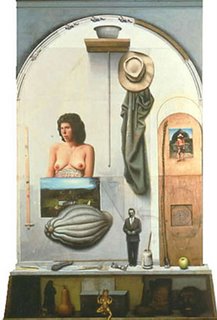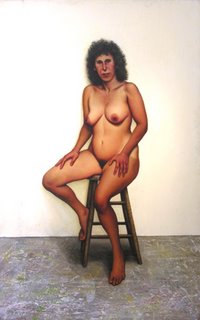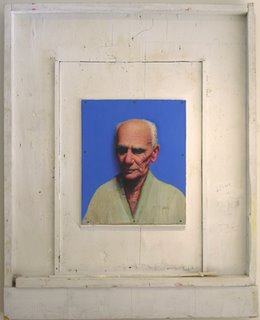Gregory Gillespie
Gregory Gillespie, the Belchertown painter who took his own life in 2000, was a master of the anxious peculiar painting. His methods, as seen in a just-concluded exhibit at Nielsen Gallery, were traditional – coming out of Northern Renaissance, William Harnett, Indian miniatures, etc. – but his effects were surreal.
 “Confirmation Shrine” (1990) is a 10-foot-tall trompe l’oeil still life. The panel becomes the artist’s studio wall and all the depicted objects appear hung on the wall or arranged on a shelf. Gillespie liked to compose pictures by meandering around his picture and adding more images as he went along, often with an everything-but-the-kitchen-sink vibe.
“Confirmation Shrine” (1990) is a 10-foot-tall trompe l’oeil still life. The panel becomes the artist’s studio wall and all the depicted objects appear hung on the wall or arranged on a shelf. Gillespie liked to compose pictures by meandering around his picture and adding more images as he went along, often with an everything-but-the-kitchen-sink vibe.
Here, a hat and apron are hung up at the right, just as they would be in a studio. But on the left things get screwy. What looks like a painted bust of his topless wife, Peg, is stuck behind a landscape painting, which in turn is behind a floating squash. The squash could be a painting of a painting of a squash – but Gillespie renders it so 3D that it resists being a picture within a picture and insists, disconcertingly, to be a squash hovering in mid air.
From across the gallery, it’s hard to tell what’s real and what’s illusion. Gillespie sticks a real molding across the top of the picture to screw with our sense of what's what. Perception is further confounded because the sides of the picture step out, matching the perspective lines of the shelf section, even though the shelf and all the stuff on and in it are flat illusion. Except for a board running across the bottom – or so I thought. It looked like a real board, but upon closer inspection I realized it was paint.
 It’s all a joke on Renaissance perspective. Gillespie is toying with us. You feel like a mouse, and he’s a cat.
It’s all a joke on Renaissance perspective. Gillespie is toying with us. You feel like a mouse, and he’s a cat.
“Portrait of Peg Seated” (1992), rendered in oil on an 8-foot-tall panel, is a life-sized portrait of Gillespie’s wife sitting on a wooden stool in what looks like an empty corner of an artist’s studio. Gillespie’s realism puts her vividly in the same space as us – right down to her tan lines and the freckles on her chest and arms – creating a blushingly personal encounter between clothed-us and this naked woman. And again Gillespie plays trompe l’oeil games. Here, the paint-splattered studio floor shifts around, at once a floor and then turning into a flat drippy abstraction, and in the process falling out from underneath Peg like a trap door.
 In “Portrait of an Old Man” (1999), the fellow’s balding head is rendered, like “Portrait of Peg Seated,” with lots of Gillespie’s signature short, nervous brushstrokes. The marks feel creepy – like the flesh is rotting and each brushstroke is a squirmy worm.
In “Portrait of an Old Man” (1999), the fellow’s balding head is rendered, like “Portrait of Peg Seated,” with lots of Gillespie’s signature short, nervous brushstrokes. The marks feel creepy – like the flesh is rotting and each brushstroke is a squirmy worm.
Gregory Gillespie, Nielsen Gallery, 179 Newbury St., Boston, March 3 to 31, 2007.
 “Confirmation Shrine” (1990) is a 10-foot-tall trompe l’oeil still life. The panel becomes the artist’s studio wall and all the depicted objects appear hung on the wall or arranged on a shelf. Gillespie liked to compose pictures by meandering around his picture and adding more images as he went along, often with an everything-but-the-kitchen-sink vibe.
“Confirmation Shrine” (1990) is a 10-foot-tall trompe l’oeil still life. The panel becomes the artist’s studio wall and all the depicted objects appear hung on the wall or arranged on a shelf. Gillespie liked to compose pictures by meandering around his picture and adding more images as he went along, often with an everything-but-the-kitchen-sink vibe.Here, a hat and apron are hung up at the right, just as they would be in a studio. But on the left things get screwy. What looks like a painted bust of his topless wife, Peg, is stuck behind a landscape painting, which in turn is behind a floating squash. The squash could be a painting of a painting of a squash – but Gillespie renders it so 3D that it resists being a picture within a picture and insists, disconcertingly, to be a squash hovering in mid air.
From across the gallery, it’s hard to tell what’s real and what’s illusion. Gillespie sticks a real molding across the top of the picture to screw with our sense of what's what. Perception is further confounded because the sides of the picture step out, matching the perspective lines of the shelf section, even though the shelf and all the stuff on and in it are flat illusion. Except for a board running across the bottom – or so I thought. It looked like a real board, but upon closer inspection I realized it was paint.
 It’s all a joke on Renaissance perspective. Gillespie is toying with us. You feel like a mouse, and he’s a cat.
It’s all a joke on Renaissance perspective. Gillespie is toying with us. You feel like a mouse, and he’s a cat.“Portrait of Peg Seated” (1992), rendered in oil on an 8-foot-tall panel, is a life-sized portrait of Gillespie’s wife sitting on a wooden stool in what looks like an empty corner of an artist’s studio. Gillespie’s realism puts her vividly in the same space as us – right down to her tan lines and the freckles on her chest and arms – creating a blushingly personal encounter between clothed-us and this naked woman. And again Gillespie plays trompe l’oeil games. Here, the paint-splattered studio floor shifts around, at once a floor and then turning into a flat drippy abstraction, and in the process falling out from underneath Peg like a trap door.
 In “Portrait of an Old Man” (1999), the fellow’s balding head is rendered, like “Portrait of Peg Seated,” with lots of Gillespie’s signature short, nervous brushstrokes. The marks feel creepy – like the flesh is rotting and each brushstroke is a squirmy worm.
In “Portrait of an Old Man” (1999), the fellow’s balding head is rendered, like “Portrait of Peg Seated,” with lots of Gillespie’s signature short, nervous brushstrokes. The marks feel creepy – like the flesh is rotting and each brushstroke is a squirmy worm.Gregory Gillespie, Nielsen Gallery, 179 Newbury St., Boston, March 3 to 31, 2007.






1 Comments:
discovering Gillespie... and what he said.
Post a Comment
<< Home